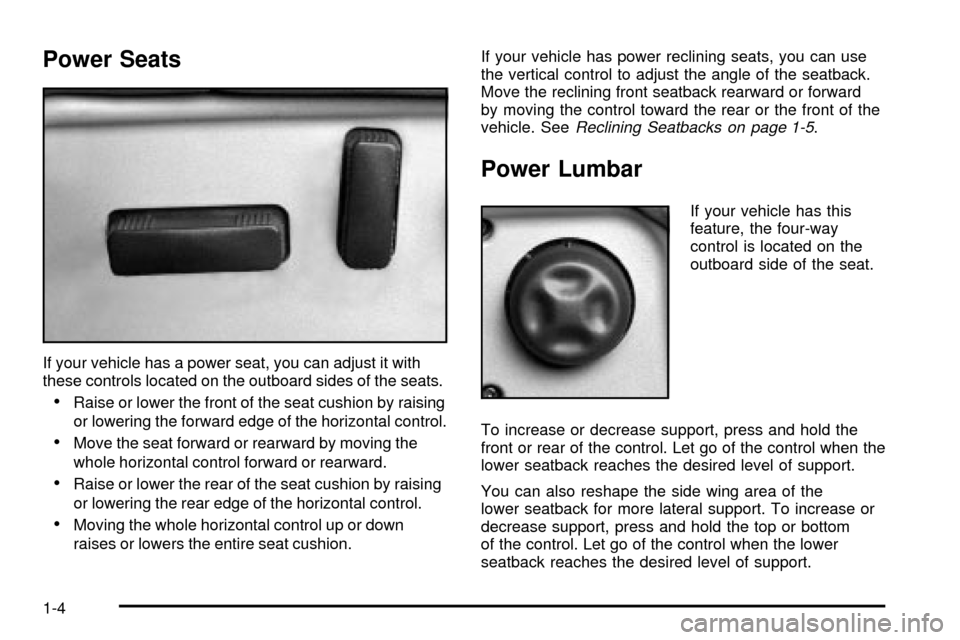2003 CHEVROLET SILVERADO tow bar
[x] Cancel search: tow barPage 10 of 556

Power Seats
If your vehicle has a power seat, you can adjust it with
these controls located on the outboard sides of the seats.
·Raise or lower the front of the seat cushion by raising
or lowering the forward edge of the horizontal control.
·Move the seat forward or rearward by moving the
whole horizontal control forward or rearward.
·Raise or lower the rear of the seat cushion by raising
or lowering the rear edge of the horizontal control.
·Moving the whole horizontal control up or down
raises or lowers the entire seat cushion.If your vehicle has power reclining seats, you can use
the vertical control to adjust the angle of the seatback.
Move the reclining front seatback rearward or forward
by moving the control toward the rear or the front of the
vehicle. See
Reclining Seatbacks on page 1-5.
Power Lumbar
If your vehicle has this
feature, the four-way
control is located on the
outboard side of the seat.
To increase or decrease support, press and hold the
front or rear of the control. Let go of the control when the
lower seatback reaches the desired level of support.
You can also reshape the side wing area of the
lower seatback for more lateral support. To increase or
decrease support, press and hold the top or bottom
of the control. Let go of the control when the lower
seatback reaches the desired level of support.
1-4
Page 349 of 556

Your dealer can help you make a good vehicle-camper
match and help you determine the CWR.
After you've loaded your vehicle and camper, drive to a
weigh station and weigh the front and rear wheels
separately. This will tell you the loads on the axles. The
loads on the front and rear axles shouldn't be more
than either of the GAWRs. The total of the axle loads
should not be more than the GVWR.
Open the driver's door and look at the Certi®cation/Tire
label to ®nd out your GAWR and GVWR.
If you've gone over the weight ratings, move or take out
some things until all the weight falls below the ratings.
Of course, you should always tie down any loose
items when you load your vehicle or camper.
When you install and load your slide-in camper, check
the manufacturer's instructions.
If you want more information on curb weights, cargo
weights, Cargo Weight Rating and the correct center of
gravity zone for your vehicle, your dealer can help
you. Just ask for a copy of²Consumer Information,
Truck-Camper Loading.²Trailer Recommendations
You must subtract your hitch loads from the CWR for
your vehicle. Weigh your vehicle with the trailer
attached, so that you won't go over the GVWR or
GAWR. If you are using a weight-distributing hitch,
weigh the vehicle without the spring bars in place.
You'll get the best performance if you spread out the
weight of your load the right way, and if you choose the
correct hitch and trailer brakes.
For more information, see
Towing a Trailer on
page 4-68.
Pickup Conversion to Chassis Cab
General Motors is aware that some vehicle owners may
consider having the pickup box removed and a
commercial or recreational body installed. Before you do
so, ®rst contact GM Customer Assistance for information
on such conversions speci®c to this vehicle. Owners
should be aware that, as manufactured, there are
differences between a chassis cab and a pickup with
the box removed which may affect vehicle safety.
The components necessary to adapt a pickup to permit
its safe use with a specialized body should be
installed by a body builder in accordance with the
information available from GM Customer Assistance.
See
Customer Assistance Offices on page 7-4.
4-67
Page 366 of 556

Weight of the Trailer Tongue
The tongue load (A) of any trailer is an important weight
to measure because it affects the total or gross weight
of your vehicle. The Gross Vehicle Weight (GVW)
includes the curb weight of the vehicle, any cargo you
may carry in it, and the people who will be riding in
the vehicle. And if you will tow a trailer, you must add
the tongue load to the GVW because your vehicle will be
carrying that weight, too. See
Loading Your Vehicle
on page 4-58for more information about your vehicle's
maximum load capacity.If you're using a weight-carrying or a weight-distributing
hitch, the trailer tongue weight (A) should be 10
percent to 15 percent of the total loaded trailer
weight (B). Do not exceed the maximum allowable
tongue weight for your vehicle.
After you've loaded your trailer, weigh the trailer and
then the tongue, separately, to see if the weights
are proper. If they aren't, you may be able to get them
right simply by moving some items around in the
trailer.
Total Weight on Your Vehicle's Tires
Be sure your vehicle's tires are in¯ated to the upper limit
for cold tires. You'll ®nd these numbers on the
Certi®cation label at the rear edge of the driver's door or
see
Loading Your Vehicle on page 4-58. Then be
sure you don't go over the GVW limit for your vehicle,
including the weight of the trailer tongue. If you use
a weight distributing hitch, make sure you don't go over
the rear axle limit before you apply the weight
distribution spring bars.
4-84
Page 546 of 556

Light (cont.)
Malfunction Indicator....................................3-49
Passenger Air Bag Status Indicator................3-40
Safety Belt Reminder...................................3-36
Tow/Haul Mode...........................................3-53
Traction Off................................................3-46
Up-Shift.....................................................3-43
Listening to a DVD................................3-97, 3-110
Loading Your Vehicle for Off-Road Driving..........4-24
Loading Your Vehicle.......................................4-58
Locking Rear Axle...........................................4-13
Lockout Protection..........................................2-12
Lock-Out Switch.............................................2-17
Locks............................................................. 2-9
Delayed Locking........................................... 2-9
Door........................................................... 2-7
Lockout Protection.......................................2-12
Power Door.................................................. 2-8
Programmable Automatic Door Locks.............2-10
Rear Door Security Locks.............................2-12
Loss of Control...............................................4-21
LOW COOLANT LEVEL..................................3-67
Low Fuel Warning Light...................................3-54
Lumbar........................................................... 1-4
Power Controls............................................. 1-4M
Maintenance, Normal Replacement Parts..........5-121
Maintenance Schedule.....................................6-12
At Each Fuel Fill.........................................6-12
At Least Once a Month................................6-12
At Least Once a Year..................................6-14
At Least Twice a Year..................................6-13
At the First 100, 1,000 and 6,000 Miles
(160, 1 600 and 10 000km).......................6-12
Brake System Inspection..............................6-18
Engine Cooling System Inspection.................6-17
Exhaust System Inspection...........................6-17
Fuel System Inspection................................6-17
How This Section is Organized....................... 6-3
Introduction.................................................. 6-2
Maintenance Requirements............................. 6-2
Part A - Scheduled Maintenance Services......... 6-4
Part B - Owner Checks and Services.............6-12
Part C - Periodic MaintenanceInspections......6-17
Part D - Recommended Fluids and Lubricants . . . 6-19
Part E - Maintenance Record........................6-22
Scheduled Maintenance................................. 6-5
Steering and Suspension Inspection...............6-17
Throttle System Inspection............................6-18
10